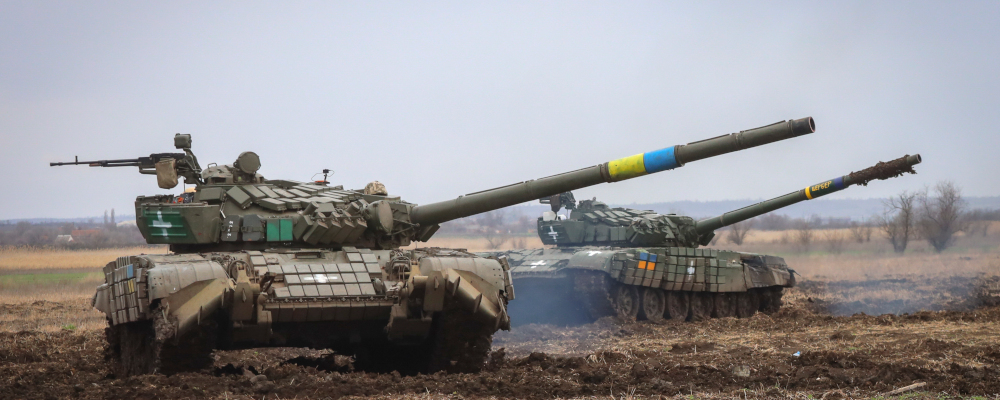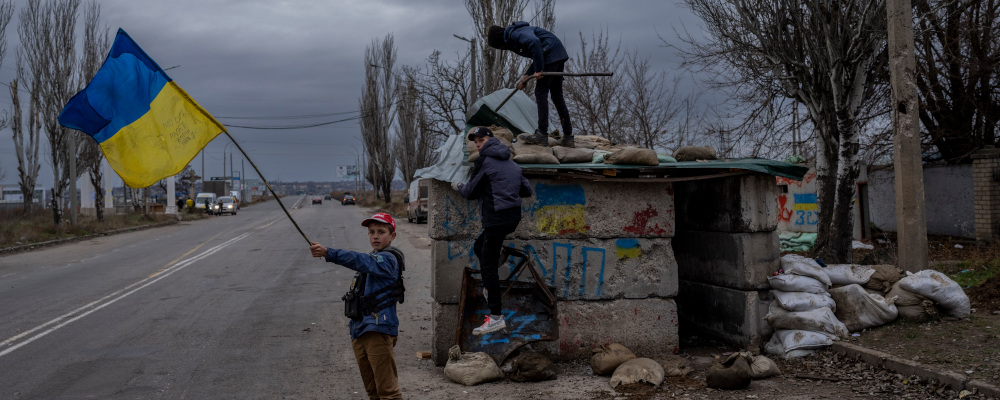Two years into Russia’s brutal full-scale invasion of Ukraine, a stalemate has now crystallized on the frontlines. Ukraine’s much-vaunted summer counter-offensive yielded a minor victory in Robotyne and minimal gains around the Dnipro River, Zaporizhzhia, and Bakhmut’s outskirts.
But Russia’s attritional offensive in Donetsk has yielded victories in Bakhmut and Avdiivka, at the cost of tens of thousands of Russian soldiers. These minor achievements are a far cry from Ukraine’s rapid-fire victories in Kharkiv and Kherson during the second half of 2022 and Russia’s substantial territorial gains during the early stages of the war.
Despite this quagmire, both Ukraine and Russia remain publicly confident of their prospects of total victory. In his December 2023 Foreign Affairs article entitled “There is a Path to Victory in Ukraine: The Delusions and Dangers of Defeatist Voices in the West,” Ukrainian Minister of Foreign Affairs Dmytro Kuleba emphatically dismantled the pessimistic assertion that Russia’s resources advantage would eventually guarantee its victory. Ukrainian President Volodymyr Zelensky has expressed optimism about Ukraine’s prospects of securing “fire control” over Crimea’s skies. Meanwhile, the commander-in-chief of Ukraine’s armed forces, Valery Zaluzhny, candidly admitted in November that, “There will most likely be no deep and beautiful breakthrough” in the near term, infuriating Zelensky and presaging his eventual ousting.

Russian officials and media outlets have reinforced their neo-imperialist rhetoric and raised the specter of Ukraine’s erasure as a state. In December 2023, Putin declared peace will be achieved when Russia achieves its goals of the “demilitarization and denazification” of Ukraine, which are euphemisms for regime change and Russian occupation. Meanwhile, Dmitry Medvedev, the hawkish deputy chair of Russia’s Security Council, recently declared that Russian forces would occupy Odesa and eventually seize the “Russian city” of Kyiv. After Russia’s triumph in Avdiivka, Russian commentator Alexei Naumov argued that the current moment is Russia’s best since the invasion began, as Ukraine is running out of aid money and troops that can be mobilized.
The near-term trajectory of the War in Ukraine is unlikely to vindicate either of these predictions. Ukraine’s incremental gains at the Dnipro River’s eastern bank in November 2023, which aimed to create a straight-line path from Kherson to Crimea and divert Russian forces from their fortified positions in Zaporizhzhia, are unlikely to be followed by further breakthroughs. The stagnation of Ukraine’s ground forces means that its inexorable degradation of Russia’s Black Sea fleet is likely to be more costly to Russia’s morale and status rather than to its hold on occupied territories. The August 2023 assassination of Wagner Group chief Yevgeny Prigozhin and the relatively smooth integration of Wagner’s Ukraine contingent into the Russian military will also limit Kyiv’s ability to capitalize on discord within Russia’s ranks. If anything, the dismissal of the extremely popular Zaluzhny for the much-maligned Colonel General Oleksandr Syrskyi could mean Ukraine has an even bigger disunity problem.
Russia’s prospects for decisive territorial gains in the near term are just as illusory. Despite overwhelming manpower and war materiel advantages, Russia has been unable to convert its victories in Donetsk’s smaller battlegrounds, such as Bakhmut and Avdiivka, into successful assaults on its larger cities Kramatorsk and Sloviansk. Russia is initiating a multi-axis offensive in the Kharkiv-Luhansk area, which is the first campaign of its kind since early 2022. However, the rigidity of its military doctrine and tactical shortcomings are obstacles.
Ukraine’s impending procurement of pledged F-16s will further challenge Russia’s air superiority. Kyiv’s planned production of thousands of long-range drones that can target military installations deep in Russian territory could lead to further war materiel losses. While Prigozhin’s death and the silencing of ultranationalist firebrands could obscure Russian military setbacks from the public, Putin is actually unlikely to be able to report any major victories either.
While the spring and summer offensive cycles are unlikely to lead to either side gaining the advantage, there is a compelling case to be made that the War in Ukraine is at a real inflection point. Russia’s isolated military allies Iran and North Korea and economic partnerships in the Global South look more resilient than Ukraine’s partnerships with Western countries. To complement its past deliveries of drones and loitering munitions, Iran recently exported hundreds of surface-to-surface ballistic missiles to Russia. North Korea has supplied Russia with one million artillery shells, which equaled the target number that the European Union (EU) missed for Ukraine. China’s trade with Russia reached a record $240 billion in 2023, as the yuan replaced the U.S. dollar in Russia’s commercial transactions.
By contrast, Ukraine’s access to war materiel from its Western partners is falling short. As the Republican-led Congress ambiguously links aid to Ukraine to U.S. border security, the U.S. has been forced to resort to assistance transfers to third countries, such as Ecuador and Greece, to help Ukraine. The U.S. has also leaned heavily on the Ukraine Security Assistance Initiative. This allows for much smaller munitions drawdowns than what a congressional aid package would afford. The Czech Republic’s plan to amass 800,000 artillery shells for Ukraine, which includes participation from Canada, will provide only a temporary respite to the Ukrainian military’s munitions shortages.
Ukraine has signed a series of bilateral security guarantee agreements with NATO countries. These pacts will help it survive the next decade of Russian expansionism. But they do little to ameliorate pressing supply shortages on the frontlines, which have been publicly exposed by Ukrainian military commanders and soldiers who are stoically resisting Russian advances. Sanctions are formidable weapons, but they alone have not stopped Russia’s ability to replenish its precision missile stockpiles or procure dual-use goods from countries like Turkey, the United Arab Emirates, Serbia, and Kazakhstan.
Russia’s axis of illiberal allies has outlasted Ukraine’s coalition of liberal democracies. And this trend shows few signs of reversing itself.
On the Right, skepticism of Ukraine is on the rise, and it is manifesting itself in various forms of passive and active obstructionism. Speaker Mike Johnson’s decision to send the House into recess while the Ukraine aid debate remains unresolved will further strain Kyiv’s supply chains. Conspiracies about Ukraine’s alleged misuse of U.S. military aid have been dismissed by senior Republicans, such as House Foreign Affairs Committee Chair Michael McCaul, but remain regular talking points amongst aid-skeptical MAGA Republicans.

Canadian conservatives are alarmingly showing signs of emulating this trend. A recent poll showed that 43 percent of Conservative Party voters in the 2021 election believe Canada is doing too much to aid Ukraine, which is an increase from 19 percent in May 2022. The Conservative Party’s resistance to a Canada-Ukraine free trade agreement over its mention of “carbon pricing” is merely the tip of the iceberg in a broader spike in Ukraine skepticism. But, Britain’s Conservative government which is leading a coalition with Latvia on drone distributions to Ukraine, and right-wing Italian Prime Minister Giorgia Meloni, who recently encouraged her Hungarian counterpart Viktor Orban to soften his opposition to aiding Ukraine, present more encouraging examples. But this goodwill is not sufficient to keep Ukraine’s resistance afloat.
While the commitment gap towards Ukraine is most pronounced on the right, it is not confined to conservative movements. Across the political spectrum, Ukraine defeatism is starting to creep in. President Joe Biden’s pledge to support Ukraine as “long as we can” during Zelensky’s December 2023 visit to Washington was not one of his trademark gaffes. In recent months, U.S. and European officials have broached the prospect of peace negotiations with Russia. These negotiations would force Ukraine into territorial concessions. It plays right into Russia’s strategy for victory in Ukraine in 2026, which consists of grinding down Western resolve to the point that currently occupied territories plus Kharkiv and Odesa become negotiable. The failure of the U.S. Congress to pass an aid package to Ukraine after the murder of opposition leader Alexei Navalny will only add to Russia’s confidence.
The expansion of Ukraine defeatism amongst the Canadian public is just as striking as the rise of Ukraine skepticism in Canada’s Conservative Party. A February 2024 poll showed that 30 percent of Canadians believe Ukraine should pursue a deal with Russia that cedes territory, while just 40 percent of Canadians are convinced that Ukraine should keep fighting. The modest but encouraging uptick in Canadian public support for military assistance deliveries to Ukraine is chimeric in the broader political context.
While the War in Ukraine remains locked in a stalemate, the rise of Ukraine skepticism and Ukraine defeatism in the West presents an alarming challenge to Kyiv’s long-term ability to resist Russian aggression. The inefficacy of Russia’s military doctrine has bought time for the liberal international order. But two years after Russian tanks appeared on the outskirts of Kyiv, it is clear this reprieve is not indefinite.




